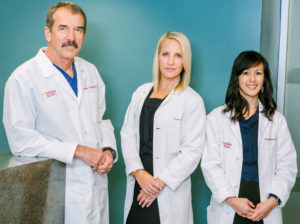USC Fertility doctors, leaders in the field of assisted reproduction.

Following the birth of the world’s first in vitro fertilized baby, Louise Brown, in 1978 in Great Britain, a program for in vitro fertilization (IVF) was begun at USC. The program achieved the birth of the second in vitro fertilized baby in the United States in 1982. Dr. Richard Paulson joined the program in 1984, and the following year USC achieved the birth of the first baby born as a result of embryo freezing and thawing in the United States.
The second IVF baby born in the United States was conceived at USC Fertility.
In 1986, Dr. Paulson was named the director of the fertility program at USC. The program was among the first to offer the new technology of ultrasound-guided follicle aspiration, which quickly became the standard method of oocyte retrieval. A direct result of this new technology was the development of unstimulated IVF, which uses the body’s own natural cycle to select and mature a single dominant oocyte, thus making IVF technology available to women who do not respond to or cannot take fertility medications. The USC program is credited with much of the early work and research in the area of unstimulated and minimal stimulation IVF.
USC Fertility doctors were a pivotal force in the development of IVF and egg donation.
Oocyte donation represented a unique physiologic configuration in which both the ovarian stimulation as well as the uterine preparation could be optimized independently. This insight allowed the USC investigators to make major strides into the understanding of uterine receptivity and the contribution to pregnancy success made by the oocyte quality. As a result of its pioneering efforts researching the aging of the uterus and ovaries the program was among the first to successfully establish an oocyte donation program.
Careful attention to detail and standardized stimulation and retrieval protocols allowed the USC physicians to realize what others had not: that oocyte donation was associated with unprecedented pregnancy success. It also led directly to the application of oocyte donation to women of advanced reproductive age. By demonstrating that the uterus does not age with respect to uterine receptivity, the USC program was able to offer oocyte donation to women in their forties and even early fifties and achieve pregnancy results that were identical to those of younger women.
The USC contributions to milestones in oocyte donation include: first report of oocyte donation to women over 40 years of age (New England Journal of Medicine, 1990); expanded series of egg donation to women over 40 (JAMA, 1991); first report of egg donation in women over 50 (Lancet, 1993); report of successful birth after oocyte donation to world’s oldest mother at 63 (Fertility & Sterility, 1997).
USC Fertility is a leader in cryopreservation
USC Fertility initially established their expertise in cryopreservation with their embryo freezing program. Embryo freezing was established in order to preserve excess embryos at the time of a fresh IVF cycle. Subsequently, embryo freezing has now become the most proven method of fertility preservation for women with cancer prior to chemotherapy. After successfully implementing our embryo cryopreservation program the physicians and embryologists turned their attention towards perfecting egg freezing. USC was one of the earliest adopters of egg freezing starting in 2004. Here at USC Fertility we have the most experience on the west coast with thawing of oocytes with subsequent transfer resulting in live births.
The USC Fertility program has been and continues to be a leader in IVF and fertility treatment nationwide.
The program continues its commitment to provide state of the art high quality medical services to infertile couples, single women and LGBT couples in a personal supportive environment. Because a full range of services is available, care can be individualized. As assisted reproductive moves into the 21st century, USC Fertility is committed to remaining in a leadership role and to continue to develop techniques and expand the fund of knowledge, which makes reproduction an attainable reality for all who cannot conceive without specialized assistance.
